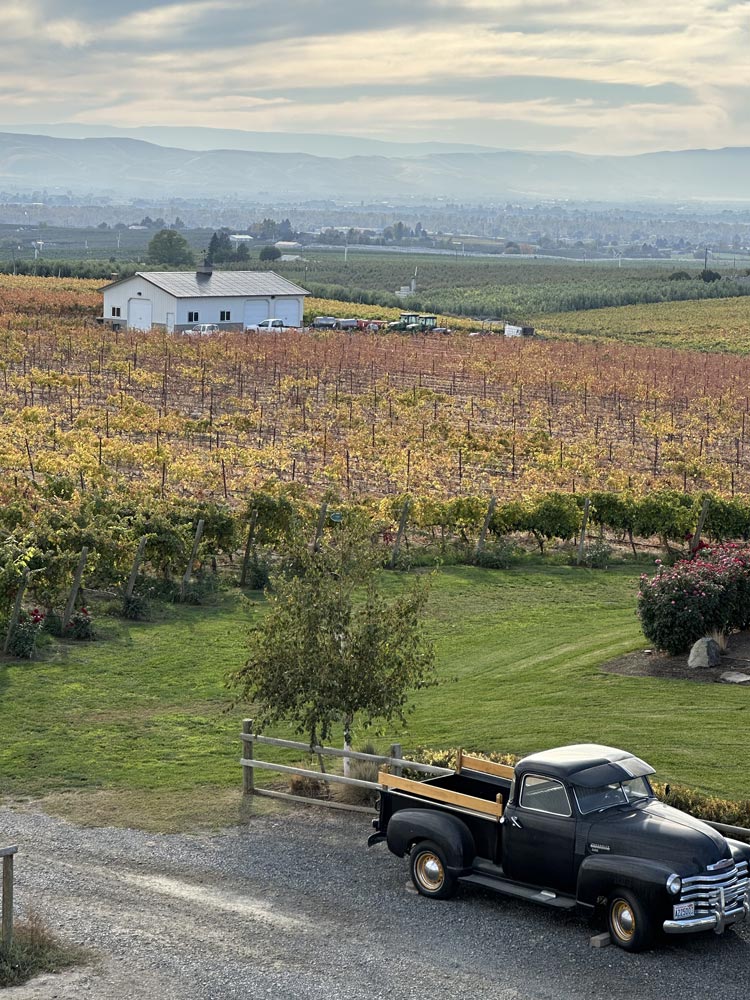
Join us in exploring the nuances of this captivating wine region.
Situated in the Yakima Valley of Washington State, the Rattlesnake Hills AVA (American Viticultural Area) is celebrated for its unique terroir, where the convergence of gentle rolling hills, unique soils, elevated terrain, favorable climate, and farming tradition are pivotal elements in shaping the characteristics of its wines.
The term, “The Hills” has emerged from the landscape’s rolling, hilly beauty in the western foothills of the Rattlesnake Hills Range where Mount Adams and Mount Rainier frame the view to the west. The region is home to some of Washington State’s most iconic vineyards; including Copeland, DuBrul, Dineen Elephant Mountain, Pollard, Sheridan and Two Blondes, among others. Recognized for its commitment to world-class viticulture and high-quality wines, the region is synonymous with the intersection of tradition and innovation. Join us in exploring the nuances of this captivating wine region.
This unique terroir, found nowhere else in the world
The Hills, or Rattlesnake Hills AVA, is nestled in the westernmost foothills of the Rattlesnake Hills Range in the Yakima Valley and boasts a diverse range of soil types, underlain predominantly by the unique bedrock known as the Ellensburg Formation. This formation, comprised of sandstones, siltstones, mudstones, and conglomerates, imparts distinct mineral components to the soil vineyard rooting zone, setting it apart from the Missoula flood-derived soils predominantly basalt-driven bedrock prevalent in the most growing regions in the state state. The diverse soils are generally nitrogen-deficient and low in vigor, well-drained, shallow, and have the perfect high pH; allowing the vines to grow in balance and evenly forcing the vines to struggle, ripen the fruit resulting in higher quality fruit.
The presence of calcium carbonate, locally known as Caliche, further enhances the soil's richness diversity and aids in maintaining acidity in the fruit late into the growing season, contributing to the freshness of the wines.
The Ellensburg Formation, with its Miocene age of 10-15 million years, tells a geological story of tectonic compression and the folding of sedimentary stones derived from the erosion of volcanic rocks of the Cascade Range. The resulting gravelly, silty loam and stone matrix of this soft bedrock is distinctive to the Rattlesnake Hills AVA. The composition of the sediment, reflecting a silica-rich volcanic source, distinguishes the region from the greater Columbia River Basin, which is generally basalt.
Elevation stands as the defining feature of The Hills
Beyond frost protection, the elevation plays a crucial role in sun exposure, affecting the angle of the sun, the length of the day, and the diurnal shift between nighttime and daytime temperatures. This diurnal shift, additionally aided by the region’s arid climate and sometimes reaching 50 degrees Fahrenheit, is particularly noteworthy. The solar radiation allows the grapes to ripen during the day, benefiting from ample sunlight for sugar production, deep color development, and physiological ripening, while cooling off at night. This temperature fluctuation helps retain natural acidity and freshness in the grapes, imparting a distinctive character to the wines of the Rattlesnake Hills AVA.
This elevated terrain, a characteristic feature relative to the rest of the Yakima Valley, serves as a natural shield against early spring and late fall frosts. The cold air, draining off the slopes into the lower valley, protects the vineyards and contributes to a more favorable growing environment.
The elevation also notably contributes to the region’s distinctive terroir by being located predominantly above the influence of the great ice age Missoula floods, in contrast to the vast majority of other Columbia Valley growing regions. All but a few of the lower elevation vineyards in The Hills are located “above the floods,” contributing to a distinctive, mineral-driven terroir influence.
The Hills are shielded from Pacific Ocean weather by the "Rain Shadow Effect", rendering its growing season nearly cloudless.
From The Hills, a captivating landscape unfolds with the imposing peaks of Mount Rainier and Mount Adams in the distance. This region, cleaved from the wetter and more temperate western Washington by the Cascade mountain range, is shielded from Pacific Ocean weather by the “Rain Shadow Effect”, rendering its growing season nearly cloudless. In stark contrast to the damp western Cascades and Olympics, The Hills are a Continental Semi-Arid Desert, basking in 300 days of abundant sunshine.
With a mere 7-9 inches of precipitation annually, irrigation becomes a necessity. Winegrowers in The Hills consider this a unique advantage, empowering them to judiciously provide water required at optimal times, elevating fruit quality.
The region's overall south to southwest aspect, exposes vineyards to unobstructed sunlight, resulting in an average of 3100 ~3000 annual growing degree days; one of among the top 3 AVAs in the state for warmth and much warmer than the surrounding Yakima Valley. Despite its high latitude, The Hills is sheltered from unpredictable spring and fall rains and frosts by the "Rain Shadow Effect" and high elevation, allowing grapes to mature longer on the vine, developing the region’s signature flavors. While the growing season may be slightly shorter than regions further south, the region compensates with equal "sun hours" as Napa Valley, thanks to exceptionally long days at high latitude.
The family-owned and operated vineyards nestled in The Hills embody the essence of best-in-class viticulture through their intimate connection to both the earth and vines.
Many of these dedicated growers live on the very sites where their grapes flourish, fostering a close and personal relationship with the land. This proximity allows for a unique hands-on approach, ensuring that decisions made directly impact the quality of the final product; living the well-known mantra that “Great Wine is Made in the Vineyard.”
A shared sense of pride is a common thread amongst these families. Visitors are welcomed and often greeted by these visionary families who may give personal tours of the vineyards or pour current vintages of Estate wines in the tasting room.
Beyond the realm of traditional farming, these visionary families stand as pioneers in sustainability, with some of the vineyards being among the first in the state to receive certification. Drawing on a rich heritage, some of these vineyards were planted in the 70s and 80s, showcasing a longstanding commitment to excellence that has positioned them as leaders in the wine industry.
